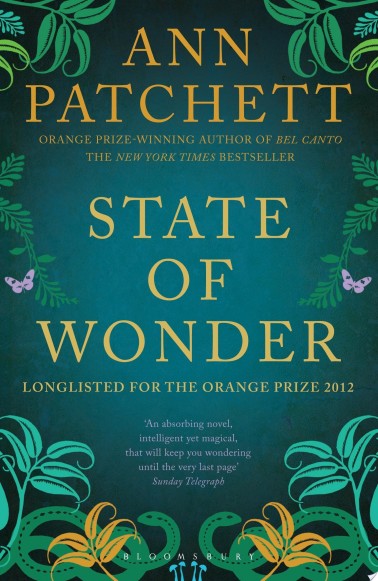As re:Cycling explores media representation of the menstrual cycle, we’ve chosen to republish a three-part series I wrote about how author Ann Patchett uses the menstrual cycle as a major plot devise in her novel State of Wonder. Part 1 was originally published on January 22, 2015.
State of Wonder–Part 1: Wondering about missing menstrual mentions in literature
In her novel State of Wonder Ann Patchett explores, among many broad themes, the question: What if there were a drug women could take to extend menstruation and fertility into their seventies? Not evident on the dust jacket, this storyline grabbed the attention of this menstrual cycle advocate.
 Set mainly in the jungle of Brazil, the novel revolves around the decades-long research of Dr. Annick Swenson who has kept the location and progression of her research secret from the drug company funding her work with the fictional Lakashi tribe. When a male scientist sent by the drug company to find Dr. Swenson and deliver a message is reported dead, Dr. Marina Singh, a research pharmacologist, becomes the second emissary charged with finding Dr. Swenson and assessing her progress towards the promised drug.
Set mainly in the jungle of Brazil, the novel revolves around the decades-long research of Dr. Annick Swenson who has kept the location and progression of her research secret from the drug company funding her work with the fictional Lakashi tribe. When a male scientist sent by the drug company to find Dr. Swenson and deliver a message is reported dead, Dr. Marina Singh, a research pharmacologist, becomes the second emissary charged with finding Dr. Swenson and assessing her progress towards the promised drug.
Finding Dr. Swenson is a formidable task, but when she does Marina eventually learns the complex botanical explanation for the Lakashi’s extended fertility, as well as the justifiable reasons why the research location has been so scrupulously protected.
This literary novel, a satisfying read, powerfully renders the mystique of the Amazon jungle, conveying both the wonder and trauma Marina experiences there. For an insightful review of State of Wonder I’d recommend Lydia Millet’s. This series of posts is not a review, but rather commentary on the niggling details related to the extended fertility storyline. Spoiler Alert: Some plot points will be revealed.
After a few weeks in the jungle—the timeline is fuzzy—Marina is invited by two other female researchers to the grove of Martin trees where she observes Lakashi women of all ages scraping tree bark with their teeth, a practices she is told that begins at menarche and is the key to their lifelong fertility.
Marina learns the women chew the bark every five days except when they are menstruating and when they’re pregnant; the bark repulses them from the moment of conception. She is told also that although the women don’t all come to the grove on the same five-day cycle, they’re menstrual periods are “pretty much” synchronous so the researchers “get a few days off every month.” That is, days off from observing them in the grove while taking pin-prick blood samples and collecting cervical mucus swabs to monitor estrogen levels that Dr. Swenson has taught the Lakashi to do themselves with Q-tips. Dr. Swenson’s research team charts and studies every cycle of every menstruating girl and woman.
The researchers tell Marina they also chew the bark and invite her to try it. Here is where, in a story that speaks intimately about the tribal women’s menstrual cycles, I wondered why Patchett did not include even one sentence to acknowledge when Marina had her last period. (At 42 she has thought about her fertility and her prospect of having a child someday.) Because she scrapes the bark one assumes she isn’t menstruating, and she’s been in Brazil long enough–weeks spent in Manaus before getting to the jungle–to have had at least one period. Where is she in her cycle? This matters because of what happens later in the story. So, since menstruation is integral to the novel, why not mention it? And why don’t the other female researchers mention whether their cycles, too, have synchronized with the Lakashi’s?
In most novels, probably too many, the menstrual cycles of female characters are invisible unless they figure prominently in the plot. It made no sense to me that Patchett chose to make Marina’s cycle invisible. Even if readers can deduce this missing information, surely this is the wrong novel in which to require us to do so. Again, I ask, “Why?”
Laura Wershler is a veteran sexual and reproductive health advocate and writer, SMCR member, and editor-in-chief of re:Cycling.

